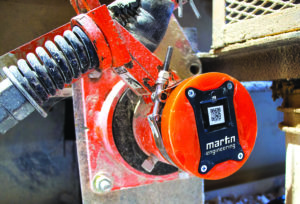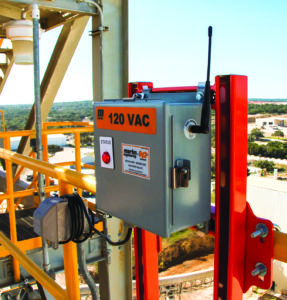
The N2 PI notifies service personnel when a cleaner requires retensioning or replacement.
Martin Engineering has introduced a belt-cleaner position indicator that monitors the blade, tracking and reporting remaining service life. The N2 Position Indicator (PI) monitors primary belt-cleaner blades, notifying service technicians and mine and plant operations personnel when retensioning or replacement is required and/or when abnormal conditions occur. The PI can be retrofitted to existing mainframes that use the company’s replacement blades. Managers and service technicians can quickly access information on any networked cleaner with smart phones.
With approximately 1,000 operating systems currently in service, the technology has been embraced by bulk material handlers in a wide range of industries and applications. Designed in-house by the engineering team at Martin’s Center for Innovation (CFI), the N2 PI is produced solely in company-owned facilities to ensure the highest standards for quality control. In fact, the firm also engineered and built the proprietary equipment used to manufacture the new devices.
Martin offers the equipment, monitoring service and batteries free of charge to qualifying customers. The company will also support the PI components and provide customer alerts without cost as needed, with mainframes and tensioners replaced free for users of Martin belt cleaner blades.
“There are no annual maintenance fees, and no add-on charges for cell phone access,” said Brad Pronschinske, global marketing director for Martin Engineering. “Most mines using our cleaner blades can take advantage of this technology.”
The PI’s can be mounted anywhere from 3 to 800 meters (10 to 2,625 feet) from the cellular gateway, and the robust, sealed construction means it is virtually immune from damage. Up to 50 units can be monitored by a single gateway connecting to the Internet, usually located at the highest point in the plant, where the cell signal is strongest. The system does not require a cellular line for each PI, instead communicating via radio frequency from each sensor to the gateway

Up to 50 units can be monitored by a single gateway connecting to the Internet.
Operating independently of any plant communications infrastructure, the small physical size and low power requirements deliver a projected battery life of two years. The self-contained model was developed by Martin to minimize the dependency on in-plant resources. Only the gateway requires a constant 110-volt power point.
The device eliminates the need for manual inspections by giving technicians precise information, delivering critical real-time intelligence and reducing exposure to moving conveyors, improving both efficiency and safety. Maintenance planning is simplified by having detailed information available on demand, allowing service personnel to deliver and install replacement wear parts during scheduled outages.
Alerts are also provided automatically when:
A blade change is required;
Retensioning is needed;
A cleaner has been backed off the belt;
There is an abnormal condition;
A substantial change in temperature occurs; and
Batteries need replacement.
Conveyor Evolution
The PI is just one component of the company’s decades-long push to develop new and evolving technologies to improve bulk material handling and reduce the associated hazards. It’s part of the same product family as Martin’s automatic tensioning system to continuously maintain optimum blade pressure without any operator intervention.
“This capability is a true enabler, bringing a number of benefits,” Pronschinske said. “Belt cleaner inspection time is basically eliminated, as maintenance personnel no longer need to physically view the cleaner to determine the tension or wear status. It also reduces the time workers need to spend near the moving conveyor, helping to minimize the potential for accidents.”
Pronschinske described the innovation as a game-changer in the industry, with a positive impact on productivity, operating costs and safety. Relying on actual operating conditions instead of human judgement to monitor blade wear and tension for optimal cleaning performance, the indicator maximizes the blade’s usable surface area and reports with certainty when a blade is nearing the end of its useful life. Delivering instant, continuous feedback while eliminating guesswork — tracking the individual performance and status of each cleaner — the detailed history also provides a maintenance log with service dates and work performed.
The result is an improved return on belt cleaner investments. Replacement parts can be scheduled for just-in-time delivery, and installation can occur during planned downtime instead of emergency stoppages. “By monitoring the rotation of the belt cleaner mainframe, the N2 Position Indicator helps managers plan tensioner adjustments and blade replacements during scheduled outages,” Pronschinske continued.
The PI itself is a self-contained system that does not require an external power source. Manufactured from a proprietary grade of polyurethane that is very resistant to bumps, shocks and knocks, the device is extremely robust. This material was chosen after Martin investigated numerous options and determined that other materials were simply not able to handle the challenges of severe operating environments. Able to handle a typical mining environment, the device can be installed inside or outside the transfer chute. It has also been designed to be reliable in the challenging ambient environment found at operator sites, such as handling wet and sticky materials.
“The system recognizes how much rotation is acceptable before tensioner adjustment is required,” Pronschinske said. “It allows our service technicians to know exactly when a belt cleaner needs replacement, even before the customer does. And if excessive movement is detected on any cleaner, an alarm notice will automatically be sent to alert operators to check it immediately.” The software tracks and displays blade status, remaining life, next scheduled tensioning, run time, wear rate, cleaner model, blade type and a number of other details.
“No other manufacturer has done more to advance the science of bulk material handling over the last 75 years, and Martin Engineering’s work-shops have been teaching customers how to operate and maintain clean and safe belt conveyors for nearly 30 years,” Pronschinske said.
The company’s Foundations reference books are an internationally recognized resource for safety, maintenance and operations training — with more than 20,000 print copies in circulation around the world.
Like all Martin products, the new N2 products are covered by the firm’s “Absolutely No Excuses” guarantee.


